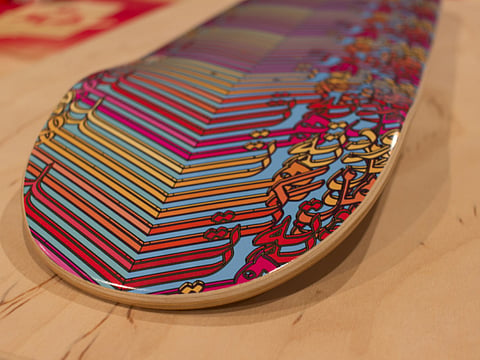Cultural connection
An exhibition examines the parallels between spiritual and urban cultures in Saudi Arabia and Utah

The Utah Museum of Contemporary Art (UMOCA) in Salt Lake City, United States, is hosting Cities of Conviction, an exhibition that brings together two seemingly different places and cultures. The show features works by contemporary artists from Saudi Arabia but it reveals surprising similarities between the two places, with the issues addressed by the Saudi artists resonating strongly with the concerns of the people of Utah. The show has been organised in collaboration with King Abdulaziz Center for World Culture (Ithra), and coordinated by Culturunners as part of a 10-city tour across the US by Saudi artists, aimed at promoting cross-cultural dialogue and understanding between the two nations.
The exhibition, curated by Jared Steffensen of UMOCA, features works by established and emerging Saudi artists such as Abdullah AlOthman, Abdulnasser Gharem, Ahmed Mater, Arwa Alneami, Nugamshi, Dana Awartani, Ghada Al Rabea, Khalid Bin Afif, Khalid Zahid, Lina Gazzaz, Moath Alofi, Musaed Al Hulis, Nasser Al Salem, Nouf Alhimiary, Qamar Abdulmalik, Rashed Al Shashai, Telfaz11, Yusef Alahmad and Balqis AlRashed, who is the first international artist to do a residency at UMOCA.
“This exhibition examines the parallels between spiritual and urban cultures in Saudi Arabia and Utah, especially the symbolism of creativity that connects cities of pilgrimage in both places. Since the 7th Century, the holy cities of Makkah and Medina have drawn millions of Muslim pilgrims every year to worship at the holiest sites in Islam. Salt Lake City was established nearly a thousand years later by Mormon pioneers in search of a safe haven for their newly established religion. Members of the Church of Latter Day Saints also make a twice-annual pilgrimage of the faithful to the General Conference at Temple Square — the spiritual centre of the Mormon faith,” Steffensen says.
“The artists featured in this show are engaged in looking at the struggles and transformations of their society and delving into complex issues that link Utah and Saudi Arabia, such as oil, pilgrimage and tension surrounding commercial development around important cultural and religious heritage sites. They, as do many Utahans, question the long-term stability of relying on non-renewable resources to fund transformation. As Saudis inch towards a more globally-influenced culture, Salt Lake’s Latter-day Saint communities are learning to accept the changing cultural landscape resulting from the influx of new residents from all over the world. This exhibition seeks to create an open dialogue about our understanding of Saudi faith and culture, as well as our own — and what these changes could mean for the citizens of Saudi Arabia and Utah,” he adds.
The artworks in the show are rooted in Saudi culture and address local issues but they are also relevant to Utah, and in the global context. For instance, in Mater’s Evolution of Man, a sequence of X-rays shows a petrol pump morphing into a human figure holding a gun to its head, reminding us that our dependence on non-renewable resources is leading us to self-destruction. Awartani’s video, I Went Away and Forgot You, looks at another aspect of this issue. She used sand collected from the Saudi Arabian desert, that she coloured with natural pigments to recreate a typical Islamic tile pattern on the floor of an abandoned house in the old area of Jeddah, and then swept it away with a broom, to speak about how we are forgetting our traditional culture and heritage and losing our identity in the mindless pursuit of modernisation.
Al Rabea, from Medina, has used candy wrappers to create collages that depict everyday life in her country, and to ‘Arabise’ Western figures such as Frida Kahlo and Van Gogh. While evoking childhood memories, her artworks comment on the impact of globalisation and contemporary consumer culture on our lives. Afifi, who is from Makkah, has used motion sensors and digital technology to create, The World, an installation featuring five huge eyes that represent all of humanity, and rotate, nod or whirl in response to the movement of the audience. As the eyes move together in harmony or away from each other fearfully, they reflect the state of the world.
New York-based Alahmad’s skateboards, painted with traditional Islamic patterns, highlight the possibility of the coexistence of two different cultures, while referencing, both the skateboarding culture in the US, and the changes happening in Saudi Arabian society.
Other works in the show comment on contemporary global issues such as the refugee crisis and consumerism. These include Abdulmalik’s installation of a crane machine game filled with passports of countries desired by refugees; and Al Shashai’s stained glass windows made from plastic colanders.
Cities of Conviction will run at the Utah Museum of Contemporary Art, Salt Lake City, USA, until January 6, 2018.
Sign up for the Daily Briefing
Get the latest news and updates straight to your inbox



